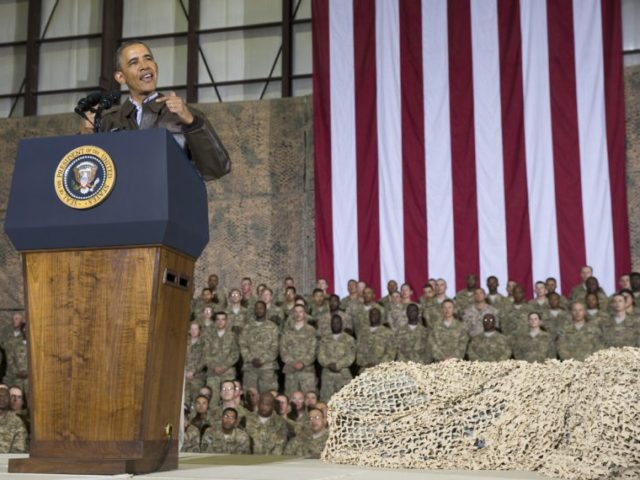A discussion about President Barack Obama’s legacy cannot ignore his policies in Afghanistan, where security conditions continue to deteriorate primarily at the hands of the Taliban, Afghans have suffered record casualties, and U.S. military fatalities have dramatically increased under his watch.
The rise of the Islamic State (ISIS/ISIL) in Iraq and Syria has continued to overshadow Obama’s war in Afghanistan even after the group established its still growing branch in the South Asian nation.
The president’s legacy on Afghanistan cannot be measured without taking into account what he inherited from George W. Bush. President Bush had been well aware at the end of his presidency that he was leaving behind Afghanistan a challenge. In his memoir Decision Points, he acknowledged Afghanistan was “unfinished business,” adding that the effort to transform the country into a stable democracy had “turned out to be more daunting than I anticipated.”
Nevertheless, the war found a successor willing to put in more time and resources, including human capital, into the ongoing effort.
“As President, I will make the fight against al Qaeda and the Taliban the top priority that it should be. This is a war that we have to win,” Obama vowed in a major 2008 campaign speech on the wars in Iraq and Afghanistan. Obama also vowed to turn the “good war” in Afghanistan around and pull out all U.S. service members.
Eight years later, U.S. military fatalities in the war have more than quadrupled from 558 under Bush to 2,247 under Obama, Pentagon data shows. There were 1,689 U.S. military deaths in Afghanistan under Obama, a figure that makes up more than 75 percent of all American fatalities since the war started in October 2001. The number of U.S. military injuries has increased more than 7-fold, from 2,702 under Bush to 20,237 now, according to Pentagon figures.
The number of U.S. military injuries under Obama’s watch (17,535) account for more than 90 percent of all 20,237 wounded in action incidents throughout the 15-year-old war.
Almost immediately after implementing his own strategy, violence dramatically worsened in 2009, peaking in 2010, the deadliest year (497 deaths) for U.S. troops in Afghanistan.
Obama presided over the top three deadliest years of the war: 2009 (303 deaths); 2010 (497 deaths); and 2011 (399). U.S. military fatalities under Bush peaked in 2008 at 151, according to a Breitbart News analysis of Pentagon data.
At nearly 100,000 in 2010, the presence of the American military also reached its zenith under Obama.
The rules of engagement have also been a subject of contempt for analysts and U.S. service members alike.
A top commander of U.S. and NATO troops indicated that, after the end of the combat mission on December 31, 2014, American forces fighting Taliban jihadists had to wait to be shot at first to be able to attack. Being a member of the Taliban was no longer a justification for U.S. troops to open fire, attack a even as the terrorist group expands its territorial control across the war-ravaged nation.
The Taliban currently controls more territory now than at any time since the group’s regime was dethrone by the U.S. military in 2001. In the year after President Obama declared an end to the U.S. combat mission (2015), the Taliban surpassed their ISIS jihadist rivals as the the world’s chief perpetrators of terrorist attacks, with 1,093 individual attacks, reported U.S. State Department.
Nevertheless, U.S. troops are still banned from offensively attacking the Taliban. American forces can only attack from a position of defense.
Despite allegations to the contrary by the Pentagon, American troops continued to be drawn into combat against a resilient Taliban after Obama said U.S. forces had ceased their combat mission in the country, as do their Afghan counterparts. While a lot can be said about the capability lapses suffered by the Afghan National Defense and Security Forces (ANDSF), which include police and army units, it is difficult to argue the Afghans lacked the will to fight to defend their country. More Afghan forces died in some one-year periods than U.S. military service members throughout the entire war. Afghan civilians have also suffered record numbers of casualties.
In addition to the human life investment in the war, Obama’s strategy provided more American taxpayer dollars in the form of reconstruction assistance, to the tune of more than $115 billion. The congressionally-appointed Special Inspector General for Afghanistan Reconstruction (SIGAR) has found some of that money has been funneled to the Taliban under both Bush and Obama.
U.S. government policies dealing with reconstruction funds may have fueled the growth of the endemic and widespread corruption in Afghanistan and aided terrorist groups targeting American soldiers, reported SIGAR.
Eradication and interdiction efforts dealing with the illicit cultivation and production of the illicit drug opium, a lucrative source of funding for the Taliban, collapsed under Obama. Afghanistan remains the world’s top producer of opium and its heroin derivative, at least a small portion of which is fueling the ongoing deadly opiate epidemic in the United States, according to the DEA.
Obama took ownership of the conflict in Afghanistan when he escalated U.S. military presence and operations soon after taking office. Yet in various exit speeches and press conferences involving the President, little has been mentioned about the war.
In his farewell address to the armed forces, Obama touted having reduced the number of U.S. troops in Afghanistan. A few days later, news reports surfaced that the outgoing president had decided to deploy an additional 300 U.S. Marines to the volatile and opium-rich southern Afghanistan region, a historical Taliban and al-Qaeda stronghold.
Despite vowing to pull all American forces out of Afghanistan by the time he leaves office, the President decided to change course last year and maintain about 8,400 troops into 2017.

COMMENTS
Please let us know if you're having issues with commenting.